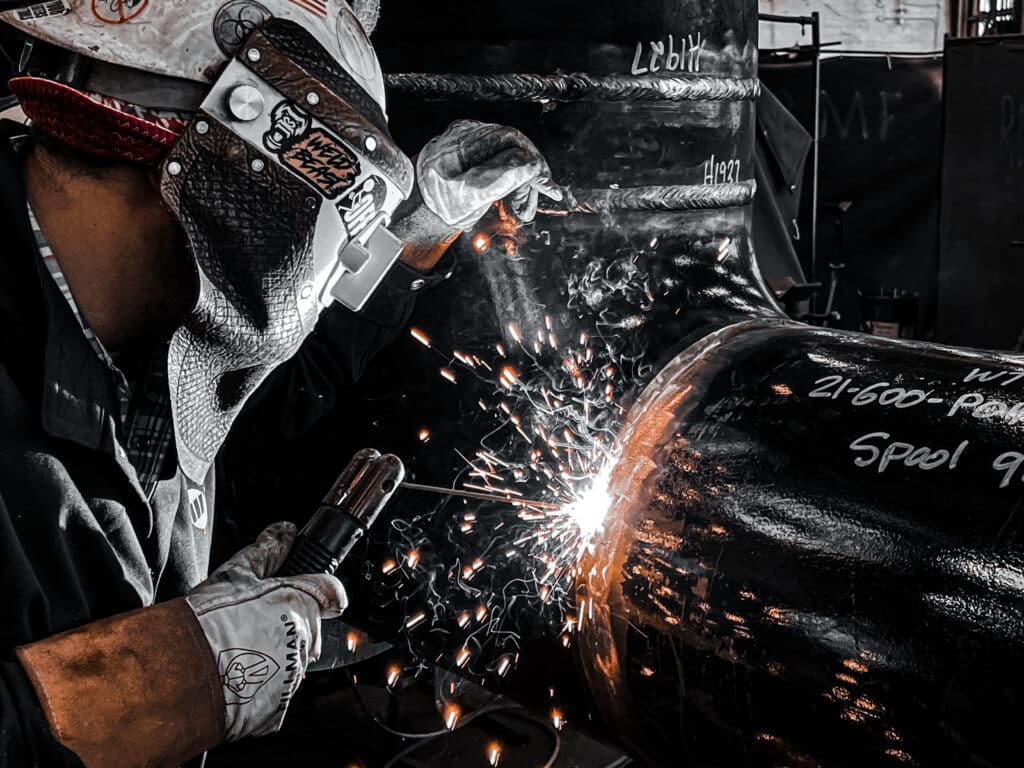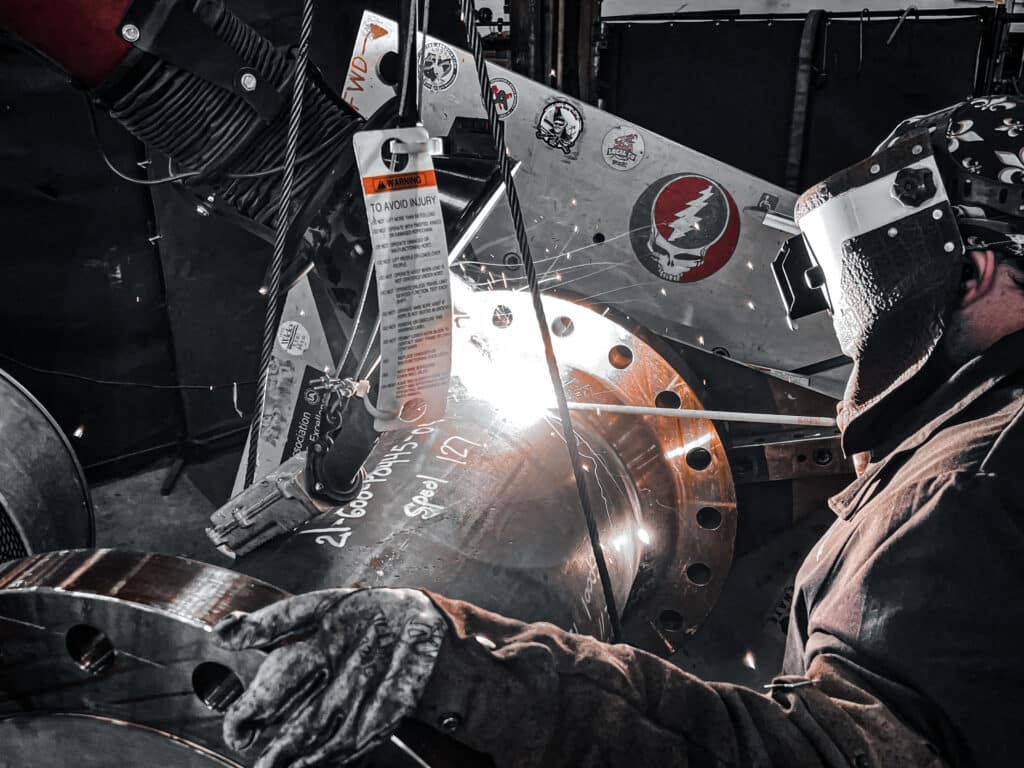What You Need to Know About Pipe Fabrication
This blog will cover the basics of fabrication, process piping, and the certifications needed to engage in professional pipe fabrication.
What is Pipe Fabrication?
This process involves cutting, bending, and assembling pipes to create piping systems. Typically, it is carried out by certified pipefitters and welders. Various procedures, materials, and designs can be used depending on the customer’s specifications.
Often, this process is used for new construction projects or for repairing existing systems. It can be performed by hand or with the support of automatic or semi-automatic machines.
Due to the complexity of fabrication and the thousands of steps involved, it requires high precision and requires hundreds of components. It is important to understand the basics when choosing a fabrication company for your project.
In order to fully understand fabrication, we must first understand what process piping is.

What is Process Piping?
This process refers to the interconnected system of pipes or tubes that transport raw materials within and throughout a facility.
They can consist of interconnected systems such as:
- Tubing
- Pipes
- Pressure Hoses
- Valves
- Separators
- Traps
- Flanges
- Fittings
- Gaskets
- Strainers
- And other components
These components can be placed together to move, mix, separate, stop, distribute or control the flow of fluids. These processes are generally involved in the conversion of liquids and gases from raw materials to usable products.
These useable products could be:
- Soft Drinks
- Gasoline
- Jet Fuel
- Cleaning Chemicals
To name a few.
Process it is NOT plumbing. Plumbing is generally what people think of when they think of piping. However, pipes in an industrial facility that are NOT associated with building’s mechanical systems, such as heating, cooling, and wastewater, are generally considered process piping.
Where is process piping generally used?
If you look at that list of useable products above and think about where those products are made, then you can make an assumption about where it is commonly used.
Facilities you will find it in:
- Oil Refineries
- Manufacturing Plants
- Food and Beverage Plants
- Paper Mills
- Power Plants
- Breweries
- Wastewater Treatment Facilities
- Chemical Plants
These are just a few of the different industries and plants that utilize these processes.
Whenever you drive by a refinery and see what looks like millions of vertical and horizontal metal tubes, you are seeing process pipes moving liquid or gases from one system to another.
Who performs the fabrication?
As you might expect, considering where these processes are used and what facilities they are in, these systems need to be well-designed, high-performing, and up-to-code standard. For fabrication to be successful, a team of professionals must be involved.
A successful fabrication team should include the following professionals:
- Pipefitters or Certified Welders
- Certified Welding Engineers
- Certified Welding Inspectors
A legitimate pipe fabrication company cannot perform without qualified pipefitters (certified welders) or a qualified quality assurance and quality control team. The two are essential for performance, meaning you cannot perform without either.
In order to become a pipefitter, a pipefitter must complete a five-year apprenticeship with the United Association. They must also pass welding qualification tests per the American Society of Mechanical Engineers, or ASME, Section IX in order to weld.
The Certified Welding Engineer Credential is granted to an individual who has qualified as a candidate based on documented training and qualifying work experience per the requirements of American Welding Society B5.16:2006 – Specification for the Qualification of Welding Engineers and has received a passing score for an examination comprised of multiple parts.
Welding inspectors examine the bonds and connections between metals. They rely on non-destructive examinations and visual tools to analyze welds and ensure they have been done correctly and safely.

What standards, codes, and procedures are followed in the fabrication process?
If you are in the industry, then you have heard of the American Society of Mechanical Engineers. If you are not in the industry, the ASME is basically the globally recognized, trusted source of standards used around the world in metal fabrication processes. In other words, the bible for all things metal.
Common codes in process piping include:
- ASME B31.3
- ASME B31.1
ASME B31.3 provides rules for design in:
- petroleum refineries
- Onshore and offshore petroleum
- Natural gas production facilities
- Chemical
- Pharmaceutical
- Textile
- Paper
- Semiconductor and cryogenic plants
- Food and beverage processing facilities
As well as other related facilities.
ASME B31.1 provides rules typically found in:
- Electric power generating stations
- Industrial and institutional plants
- Geothermal heating systems
- Central and district heating and cooling systems
Whatever the application is, these codes and standards MUST be followed in order to complete a fabrication request. If not, you have just made yourself an extremely expensive piece of scrap metal.

Nooter provides welding engineering knowledge and experience to optimize each custom fabrication project.
Whether manufacturing employees need safer access such as platforms, stairs and catwalks, or production teams need modularized units and process piping, NOOTER will expertly fabricate and install.
- Access to 1,000’s of welding procedures including specialty alloys such as Hastelloy®, nickel and Monel®.
- ASME Section VIII and Section IX Committees “We helped write the code other contractors use.”
- DOT OQ
- Full-time certified welding inspectors
- Local QA/QC managers and systems, including continuous inspection during fabrication
- Multiple fabrication shops including laydown/storage
- NDE in shop
- Welding engineer
- Code Stamp Authorizations: ASME: (A) (S) (U) (U2) (PP) Code Certifications; National Board Inspection Code “R” Stamp
Fabrication from diagram to finishing to transport to installation
- Cable tray
- Electrical components
- Fabrication, repair, modification of tanks, industrial boilers, pressure vessels
- Gas mixing skids
- Mezzanines, platforms, stairs, guard rails
- Modules
- Racks
- Supports
- Tube welding
For your next fabrication project think Nooter!
One of the country’s leading pipe fabrication companies, NOOTER brings unmatched welding engineering knowledge to every project.





